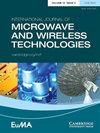Breast tumors detection using multistatic microwave imaging with antipodal Vivaldi antennas utilizing DMAS and it-DMAS techniques
IF 1.3
4区 计算机科学
Q3 ENGINEERING, ELECTRICAL & ELECTRONIC
International Journal of Microwave and Wireless Technologies
Pub Date : 2024-04-19
DOI:10.1017/s1759078724000436
引用次数: 0
Abstract
This work presents a study where a sinusoidal corrugated antipodal Vivaldi antenna (SC-AVA) operating in the ultra-wideband (UWB) region is employed as a transducer for microwave imaging (MWI) of a cancerous breast. The functionality of the antenna within the UWB range is confirmed based on performance parameters like return loss, gain, radiation pattern, fidelity factor, and group delay. E-field distribution, H-field distribution, and near field directivity simulations in the presence of the breast phantom have also been carried out and reported. The practical application of the developed antenna for biomedical imaging is evaluated by measuring the specific absorption rate (SAR) readings at multiple frequencies within its operating range. The SAR readings are obtained from an electromagnetic simulator by modelling a realistic heterogeneous breast phantom with multiple embedded tumors, and placing them in close proximity to the transducer. The modelled SC-AVA is further utilized for imaging multiple tumors hidden inside the gland layer of the heterogeneous breast phantom developed in-house. The fabricated breast phantom is scanned using the in-house developed multistatic MWI setup. Based on the data obtained from the scanning setup the images are reconstructed using both the delay multiply and sum (DMAS) and iterative DMAS imaging algorithms. Furthermore, a comparison of the reconstructed images is done to check in which case the obtained images are closer to the fabricated breast phantom.利用 DMAS 和 it-DMAS 技术,使用反节维瓦尔第天线进行多静态微波成像,探测乳腺肿瘤
本研究介绍了一种在超宽带(UWB)区域工作的正弦波纹反波德维瓦尔第天线(SC-AVA),它被用作癌症乳房微波成像(MWI)的传感器。根据回波损耗、增益、辐射模式、保真系数和群延迟等性能参数,确认了该天线在 UWB 范围内的功能。此外,还进行并报告了乳房模型存在时的电场分布、氢场分布和近场指向性模拟。通过测量工作范围内多个频率的比吸收率(SAR)读数,评估了所开发天线在生物医学成像方面的实际应用。SAR 读数是通过电磁模拟器获得的,模拟了一个带有多个嵌入式肿瘤的真实异质乳房模型,并将其放置在靠近换能器的位置。建模的 SC-AVA 进一步用于对隐藏在内部开发的异质乳房模型腺体层内的多个肿瘤进行成像。利用内部开发的多静态 MWI 设置对制作的乳腺模型进行扫描。根据从扫描装置获得的数据,使用延迟乘加(DMAS)和迭代 DMAS 成像算法重建图像。此外,还对重建的图像进行了比较,以检查在哪种情况下获得的图像更接近制作的乳房模型。
本文章由计算机程序翻译,如有差异,请以英文原文为准。
求助全文
约1分钟内获得全文
求助全文
来源期刊

International Journal of Microwave and Wireless Technologies
ENGINEERING, ELECTRICAL & ELECTRONIC-TELECOMMUNICATIONS
CiteScore
3.50
自引率
7.10%
发文量
130
审稿时长
6-12 weeks
期刊介绍:
The prime objective of the International Journal of Microwave and Wireless Technologies is to enhance the communication between microwave engineers throughout the world. It is therefore interdisciplinary and application oriented, providing a platform for the microwave industry. Coverage includes: applied electromagnetic field theory (antennas, transmission lines and waveguides), components (passive structures and semiconductor device technologies), analogue and mixed-signal circuits, systems, optical-microwave interactions, electromagnetic compatibility, industrial applications, biological effects and medical applications.
 求助内容:
求助内容: 应助结果提醒方式:
应助结果提醒方式:


